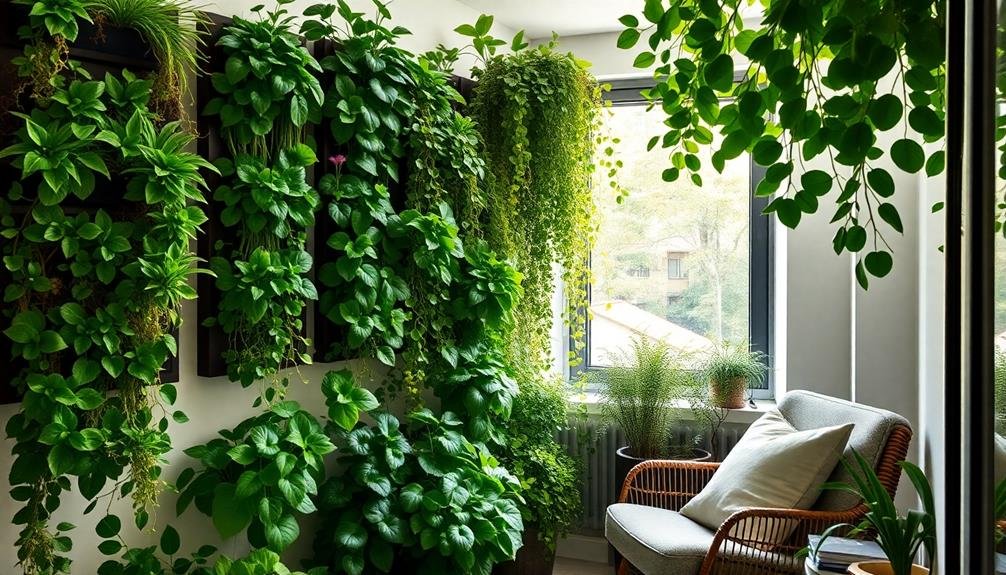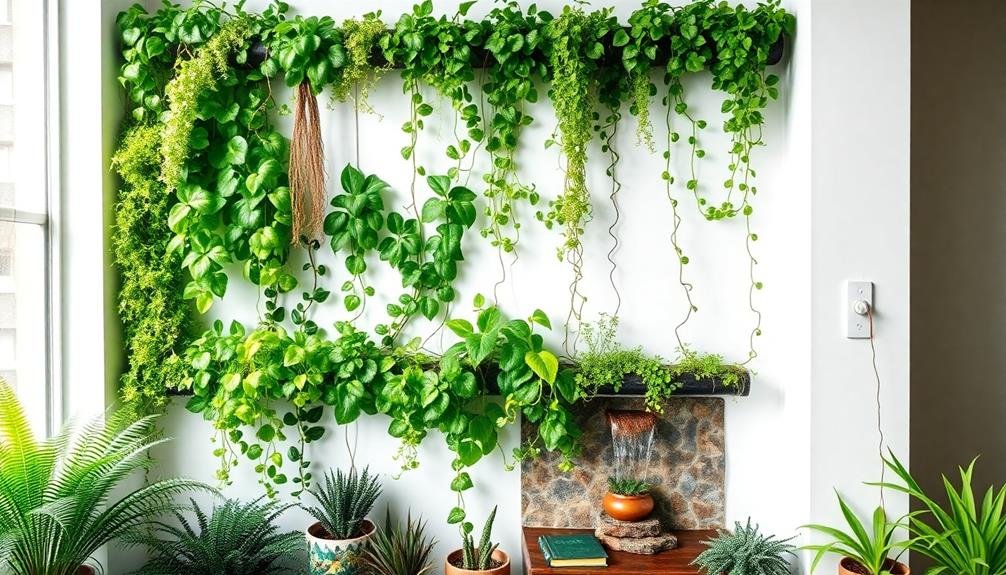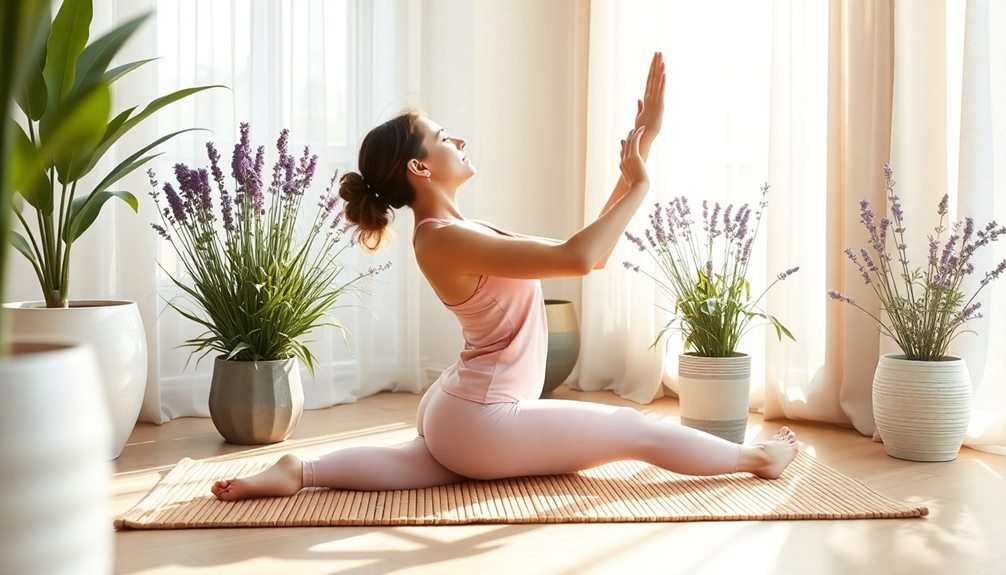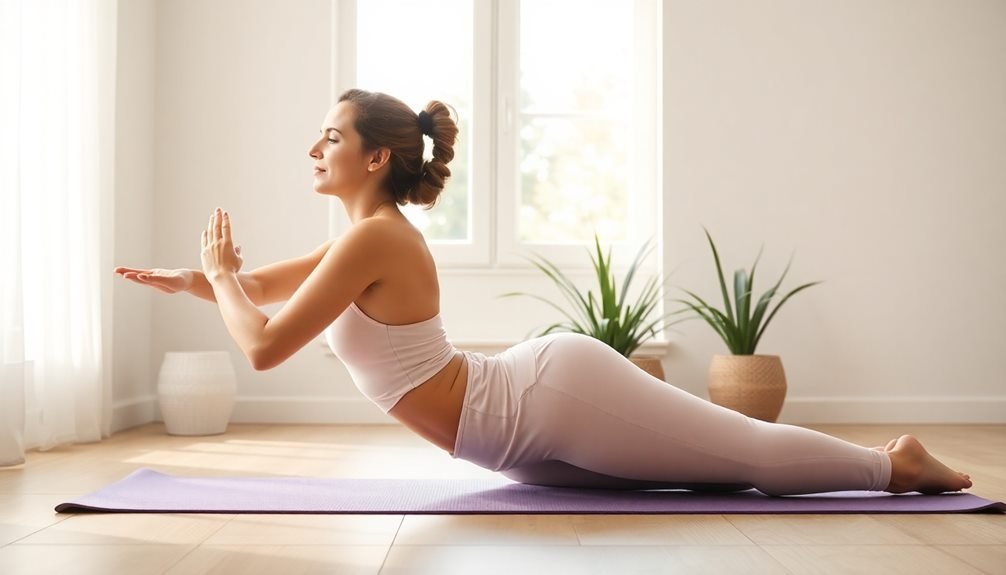Vertical gardens offer a brilliant solution for bringing nature into your small living space. They provide numerous benefits, including improved air quality, noise reduction, and temperature regulation. You'll also enjoy the therapeutic effects of gardening, which can reduce stress and boost your mood. By choosing the right plants, tools, and design ideas, you can create a calming oasis in even the tiniest of areas. From wall-mounted planters to pocket gardens, there are countless space-saving options to explore. With proper care and maintenance, your vertical garden will thrive, transforming your home into a serene retreat. Discover how to maximize your vertical space and cultivate tranquility in unexpected places.
Key Takeaways
- Vertical gardens maximize limited space, allowing urban dwellers to enjoy greenery without sacrificing floor area.
- Plants in vertical gardens improve air quality by filtering pollutants and producing oxygen in small spaces.
- Creating a vertical garden can reduce stress and boost mood through therapeutic gardening activities.
- Vertical gardens offer noise reduction benefits, acting as natural sound barriers in cramped living environments.
- Customizable designs and plant selections in vertical gardens create calming atmospheres tailored to personal preferences.
Benefits of Vertical Gardens

Despite their compact nature, vertical gardens offer a multitude of benefits for small spaces. You'll find these living walls can transform your cramped apartment or tiny backyard into a lush oasis. They're not just eye-catching; they're functional too.
Vertical gardens improve air quality by filtering pollutants and producing oxygen. You'll breathe easier and feel more refreshed in your home. They also act as natural sound barriers, reducing noise pollution from busy streets or noisy neighbors.
These gardens can help regulate temperature, keeping your space cooler in summer and warmer in winter. You'll save on energy costs while enjoying a more comfortable environment.
They're also great for urban biodiversity, attracting beneficial insects and birds to your space.
You'll enjoy the therapeutic benefits of gardening without sacrificing floor space. Tending to your vertical garden can reduce stress and boost your mood.
Plus, you can grow your own herbs, vegetables, or flowers, adding fresh ingredients to your meals or beauty to your surroundings.
Choosing the Right Plants

Selecting the right plants is essential for the success of your vertical garden. Consider low-maintenance options that thrive in vertical environments. Succulents, like echeveria and sedum, are excellent choices due to their shallow root systems and minimal water requirements. Ferns, such as bird's nest and Boston ferns, add lush greenery and adapt well to vertical growth.
For a pop of color, try trailing plants like pothos, philodendron, or string of pearls. These cascading varieties create a waterfall effect, softening the edges of your garden.
If you're after edibles, herbs like basil, mint, and thyme are compact and aromatic options that do well in vertical setups.
When choosing plants, factor in your space's light conditions. For sunny areas, consider drought-tolerant plants like lavender or rosemary. In shadier spots, opt for shade-loving species such as peace lilies or spider plants.
Don't forget to assess your ability to care for the plants. If you're often busy, select low-maintenance varieties that can withstand occasional neglect.
Essential Tools and Materials

To create your vertical garden, you'll need to gather the right tools and materials.
Start by selecting appropriate containers and planters that fit your space and design vision.
Don't forget to acquire high-quality soil and fertilizers, as well as essential watering and maintenance equipment to keep your garden thriving.
Containers and Planters
The three key elements for your vertical garden's success are containers, planters, and mounting systems. When selecting containers, prioritize lightweight options like fabric pockets, plastic troughs, or repurposed items such as pallets or shoe organizers. These choices make installation easier and reduce strain on your walls.
For planters, consider self-watering options to minimize maintenance. Look for designs with built-in reservoirs or wicking systems that keep soil consistently moist. Alternatively, use pots with good drainage and pair them with saucers to catch excess water.
Mounting systems are essential for securing your vertical garden. Wall-mounted rails or grids offer flexibility, allowing you to rearrange plants as needed. For a more permanent solution, install sturdy shelves or brackets directly into wall studs. If you're renting, opt for tension rods or freestanding structures that won't damage walls.
Don't forget to match your containers and planters to your plants' needs. Shallow-rooted herbs and succulents thrive in smaller vessels, while larger plants require deeper containers.
Always verify your chosen system can support the weight of fully grown plants, soil, and water to prevent accidents and damage to your space.
Soil and Fertilizers
Proper soil and fertilizer selection is essential for your vertical garden's health and longevity. For vertical gardens, you'll want a lightweight, well-draining soil mix that retains moisture without becoming waterlogged. A blend of peat moss, perlite, and vermiculite works well for most plants.
You can also add coconut coir to improve water retention and aeration.
When it comes to fertilizers, opt for a balanced, slow-release formula specifically designed for container plants. Look for products with an NPK ratio of 10-10-10 or 14-14-14. These will provide your plants with essential nutrients throughout the growing season.
For green, leafy plants, choose a fertilizer with higher nitrogen content. Flowering plants benefit from higher phosphorus levels.
Don't forget to supplement with liquid fertilizers every few weeks during the growing season. Dilute them to half-strength to avoid burning your plants' roots.
For organic options, consider compost tea or fish emulsion. Always follow the manufacturer's instructions for application rates and frequency.
Remember, over-fertilizing can be just as harmful as under-fertilizing, so monitor your plants closely and adjust accordingly.
With the right soil and fertilizer combination, your vertical garden will thrive in even the smallest spaces.
Watering and Maintenance Equipment
Maintaining your vertical garden requires the right tools and equipment for watering and upkeep. You'll need a reliable watering system to keep your plants thriving. Consider a drip irrigation setup or a self-watering system for consistent moisture delivery. For manual watering, invest in a long-necked watering can or a spray bottle for precise control.
Pruning shears and small scissors are essential for trimming and shaping your plants. A hand trowel and cultivator will help you manage soil and roots in tight spaces. Don't forget a sturdy step stool or ladder to reach higher sections of your garden safely.
| Tool | Emotional Benefit |
|---|---|
| Mister | Zen-like calm |
| Pruning shears | Sense of control |
| Plant monitor | Peace of mind |
For pest control, keep neem oil and insecticidal soap on hand. A small vacuum can help remove debris and unwanted insects. To monitor your plants' health, consider a soil moisture meter and pH tester. These tools will help you maintain ideal growing conditions and catch potential issues early.
Remember to store your tools properly in a nearby caddy or wall-mounted organizer for easy access and to keep your space tidy.
Space-Saving Design Ideas

With limited square footage, maximizing vertical space becomes essential for urban dwellers craving a touch of nature. Consider utilizing wall-mounted planters, which come in various styles and can be arranged in eye-catching patterns.
Pocket planters, made of fabric or plastic, offer flexibility and can be easily hung on walls or over railings. For a more structured look, try modular systems that allow you to customize your garden's layout. These often include interlocking units that can be expanded as your plant collection grows.
Repurpose everyday items like shoe organizers or pallets for an eco-friendly and budget-conscious approach. Don't overlook corners and windows. Corner shelving units designed specifically for plants can transform unused spaces into lush green nooks.
Window-box planters bring greenery to your view while saving precious floor space. For a statement piece, consider a living wall system. These larger installations can cover entire walls with plants, creating a dramatic focal point.
Alternatively, opt for a freestanding vertical garden structure that can be moved as needed, perfect for renters or those who like to change their space frequently.
Watering and Maintenance Tips

For vertical gardens in small spaces, smart watering and maintenance routines are essential. You'll need to water your plants regularly, but be careful not to overwater. Install a drip irrigation system or use self-watering planters to guarantee consistent moisture levels.
For manual watering, start at the top and work your way down, allowing excess water to trickle through the layers.
Prune your plants regularly to maintain their shape and prevent overgrowth. Remove dead leaves and flowers to encourage new growth and keep your garden looking tidy. Use sharp, clean scissors to avoid damaging the plants or spreading diseases.
Fertilize your vertical garden every few weeks during the growing season. Choose a balanced, water-soluble fertilizer and apply it according to the package instructions. Be mindful of light requirements; rotate plants if necessary to guarantee even exposure.
Check for pests and diseases regularly. Look for signs of infestation or discoloration on leaves and stems. Treat issues promptly with organic pesticides or by removing affected parts.
Creating a Calming Atmosphere

Beyond proper care and maintenance, your vertical garden can become a sanctuary of tranquility in your small space. To create a calming atmosphere, focus on engaging multiple senses. Choose plants with soft, touchable textures like ferns or lamb's ear. Incorporate aromatic herbs like lavender or chamomile to add soothing scents.
Consider the visual impact of your garden. Opt for a monochromatic color scheme with various shades of green, or select a calming palette of blues and purples. Add white flowers for a touch of serenity. Arrange plants in a flowing, asymmetrical pattern to create a natural, relaxed feel.
Incorporate gentle sound elements like a small tabletop fountain or wind chimes. The soft trickle of water or delicate tinkling can mask urban noise and promote relaxation.
Use soft, warm lighting to highlight your garden in the evening, creating a cozy ambiance.
DIY Vertical Garden Projects

Creating your own vertical garden can be a rewarding and cost-effective way to bring nature into your small space. With a few simple materials and some creativity, you'll be able to design a stunning green wall that fits your style and budget.
Start by choosing a sturdy frame or structure to support your plants. Repurposed pallets, wire grids, or modular wall planters work well. Select plants that thrive in vertical environments, such as succulents, ferns, or trailing vines. Consider light requirements and watering needs when planning your layout.
Here's a quick guide to five DIY vertical garden projects:
| Project | Materials | Difficulty |
|---|---|---|
| Pallet Garden | Wooden pallet, landscape fabric, soil | Easy |
| Pocket Organizer | Fabric organizer, potting mix, plants | Beginner |
| Wall-mounted Planters | PVC pipes, brackets, soil | Intermediate |
| Mason Jar Herbs | Mason jars, wood board, clamps | Easy |
| Gutter Garden | Gutters, end caps, chains, soil | Intermediate |
Remember to secure your vertical garden properly to prevent accidents. Guarantee proper drainage to avoid water damage to walls. With these tips, you'll create a calming green oasis in no time.
Plant Combinations for Anxiety Relief

Tranquility can be cultivated through carefully chosen plant combinations in your vertical garden. For anxiety relief, focus on plants known for their calming properties and soothing fragrances.
Lavender is an excellent choice, with its soft purple hues and relaxing scent. Pair it with chamomile, which offers delicate white flowers and a gentle aroma.
Include jasmine for its sweet fragrance and stress-reducing qualities. Rosemary not only smells wonderful but also improves memory and concentration. Add aloe vera for its air-purifying abilities and soothing gel.
Snake plants are low-maintenance and excellent oxygen producers, perfect for bedrooms. For visual appeal and added benefits, incorporate cascading plants like English ivy or pothos. These trailing plants create a lush, forest-like atmosphere while purifying the air.
Don't forget about herbs like basil, mint, and lemon balm, which offer both culinary uses and aromatherapy benefits.
Arrange these plants in your vertical garden to create a harmonious blend of textures, colors, and scents. Place taller plants at the top and trailing ones at the bottom for a balanced look.
Remember to take into account each plant's light and water needs when planning your anxiety-relieving vertical garden.
Troubleshooting Common Issues

While cultivating a calming vertical garden can be rewarding, you may encounter some challenges along the way. Common issues include overwatering, insufficient lighting, and pest infestations.
To address overwatering, guarantee proper drainage and adjust your watering schedule. For lighting problems, consider supplementing natural light with grow lights or relocating your garden to a brighter spot.
Pest control can be managed through natural methods like neem oil or introducing beneficial insects. If you're struggling with plant growth, reassess your soil quality and fertilization routine. Remember that different plants have varying needs, so it's essential to research each species in your garden.
Here are some quick troubleshooting tips:
- Yellowing leaves often indicate overwatering or nutrient deficiencies
- Brown leaf edges may signal underwatering or excessive sunlight
- Leggy growth suggests insufficient light
Don't be discouraged by setbacks; they're part of the learning process. Keep a gardening journal to track your plants' progress and any issues you encounter. This will help you identify patterns and refine your care routine over time.
With patience and persistence, you'll overcome these challenges and create a thriving vertical garden that brings tranquility to your small space.
Frequently Asked Questions
How Long Does It Take for a Vertical Garden to Fully Establish?
You'll find that vertical gardens typically take 3-6 months to fully establish. However, it is essential to recognize that this can vary depending on the plants you've chosen, your climate, and how well you maintain your garden.
Can Vertical Gardens Attract Pests or Insects Indoors?
Yes, your vertical garden can attract pests indoors. You'll need to monitor it regularly for signs of insects. Keep it clean, use proper drainage, and consider natural pest control methods to minimize the risk of infestations.
Are There Any Plants That Should Never Be Used in Vertical Gardens?
You shouldn't use invasive species, toxic plants, or heavy fruiting plants in vertical gardens. Avoid plants with aggressive root systems or those requiring extensive care. Stick to lightweight, low-maintenance options that won't overburden your structure or pose safety risks.
What's the Average Lifespan of a Well-Maintained Vertical Garden?
You'll find that a well-maintained vertical garden's lifespan varies. It can last 5-10 years with proper care. However, you'll need to replace individual plants periodically. Regular upkeep and choosing hardy species will extend your garden's longevity.
Can Vertical Gardens Affect Indoor Air Quality or Humidity Levels?
Yes, vertical gardens can improve your indoor air quality and humidity levels. They'll filter pollutants, release oxygen, and increase moisture through transpiration. You'll notice fresher air and a more comfortable environment in your home or office.
In Summary
You've now got all the tools to create your own calming vertical garden in even the tiniest of spaces. Remember, it's not just about aesthetics; it's about cultivating a peaceful oasis that nurtures your well-being. Don't be afraid to experiment with different plants and designs. With proper care and attention, you'll soon have a thriving green sanctuary that helps melt away stress and anxiety. So why wait? Start growing up and embrace the serenity of vertical gardening today!





Leave a Reply